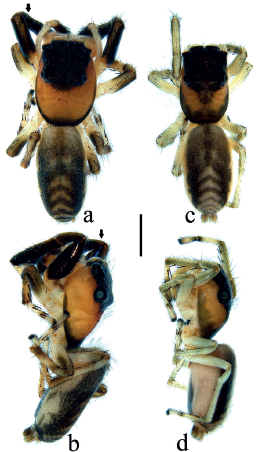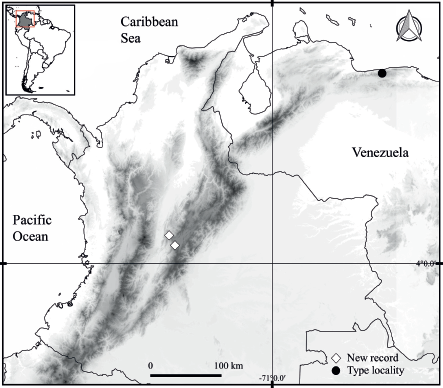The genus TanybelusSimon, 1902 and its only known species, T. aeneiceps Simon, 1902 (Salticidae: Amycoida: Sarindini), were described by Simon (1902) from males and females collected in Colonia Tovar, Venezuela. This genus includes ant-mimicking spiders with semi-rounded carapace without thoracic groove, first pair of legs larger than the others (Simon, 1902: 405), and cylindrical abdomen (pers. obs.). Subsequently to the description, Galiano (1963) made the redescription of the species and designated lectotypes. Currently, the genus Tanybelus is nested in the tribe Sarindini, in the Amycoida clade (Maddison 2015, Ruiz and Maddison 2015).
Here we report the genus Tanybelus and its species T. aeneiceps from Colombia, from the Parque Natural Chicaque (San Antonio de Tequendama municipality) and the Granjas del Padre Luna (Albán municipality), both located in the Cundinamarca department, at the Eastern Mountain Range of the country. This is a new record of the genus since its original description, more than one hundred years later. Furthermore, we give additional illustrations of sexual characters of taxonomic importance for the species, report some comments on the behavior of the species and give new data on its natural history. Finally, a distributional map is included.
The specimens were deposited in the Arachnological Collection of Instituto de Ciencias Naturales of the Universidad Nacional de Colombia (ICN-Ar, curator: Eduardo Flórez) and the Entomological Collection of Pontificia Universidad Javeriana (MPUJ ENT, curator: Dimitri Forero). The multifocal photographs were taken with a Leica MC-170 HD digital camera attached to a Leica M205A stereomicroscope, and then attached by the image stacking software Leica Application Suite version 4.6.0. The measurements were taken using an AmScope MU300 digital camera, attached to an Advanced Optics JSZ-6 stereomicroscope. The female epigynal plates were dissected and digested using 10% KOH (see Álvarez-Padilla and Hormiga 2007). The measurements are given in millimeters.
Abbreviations used in the text and figures are: cd = copulatory duct; co = copulatory opening; e = embolus; ew = epigynal window; m = meters above mean sea level; RTA = retrolateral tibial apophysis; Spe= spermophore; MNHN = Muséum National d'Histoire Naturelle, Paris, France. The information in square brackets was added to complement the label data, and was taken from the gazetteers described below. Records without coordinates in the label were approximated to locations via the gazetteers GeoLocator (http://tools.freeside.sk/geolocator/geolocator.html) and GeoNames (http://www.geonames.org/).
The distributional map was prepared in the QGIS "Lyon" (version 2.12.2, http://www.qgis.org/es/site/).
Salticidae Blackwall, 1841
Salticinae Blackwall, 1841
Sarindini Simon, 1901
Tanybelus Simon, 1902
Type species: T. aeneiceps Simon, 1902
Tanybelus aeneiceps Simon, 1902 Figs. 1-3

Figure 1 Habitus of Tanybelus aeneiceps; a. male, (ICN-Ar 8312), dorsal view, b. same, lateral view, c. female, (ICN-Ar 8313), dorsal view, d. same, lateral view. Arrows point at bluish-metalized marks on prolateral face of the femur-tibia of the first pair of legs of the male. Scale bar = 2.0 mm.

Figure 2 Structural details of Tanybelus aeneiceps; a. left male palp, (ICN-Ar 8312), prolateral view, b, d. same, ventral view, c, e. same, retrolateral view, f. left leg I, showing the metallic-blue marks on its prolateral side. g-i. Details of the epigyne of Tanybelus aeneiceps; g. uncleared (ICN-Ar 8313), ventral view, h. cleared, ventral view, i. dorsal view. Scale bar = 0.2 mm (a-c). cd Scale bar = 0.5 mm (a-e); 1.0 mm (f); 0.2 mm (g-i). e = embolus; Spe = spermophore; RTA = retrolateral tibial apophysis; cd = copulatory duct; co = copulatory opening; ew = epigynal window.
Tanybelus aeneicepsSimon, 1902: 405 by Galiano from Colonia Tovar, [Aragua], (male lectotype and paralectotypes designed Venezuela, deposited in MNHN, not examined). Galiano, 1963: 451, pl. 37, figs. 12-14 (World Spider Catalog c2017).
Diagnosis. Males are diagnosed by their long embolus, that wraps around the periphery of the bulb, and a short, and pointed RTA with a small protuberance in its base (Figs. 2a-e); while females present small and semi-rounded epigynal windows, similar but possibly not homologous to that of some Euophryini taxa, through which it is possible to see the anterior, small and rounded spermathecae, thin copulatory ducts, and the posterior copulatory openings (Fig. 2g-i). For further taxonomic information see Galiano (1963: 451).
Material examined. COLOMBIA, Cundinamarca: Albán, Granjas del Padre Luna, [4.89°N, 74.42°W], 2200 m: 1 male, 19 Oct 2001, A. Sandoval, ICN-Ar 804; San Antonio de Tequendama, Parque Natural Chicaque, entrada, El Refugio, Alrededores La Cascada y Quebrada El Carmen, 4.61°N, W 74.29°W, 2200-2560 m: 11 males, 8 females and 14 juveniles, 15-17 Oct 2016, W. Galvis, V Muñoz-Charry, Estudiantes Curso Arañas Instituto de Ciencias Naturales Universidad Nacional de Colombia, ICN-Ar 8312-8317, 8550; 1 male and 1 female with same data MPUJ_ENT 39552.
Morphological Variation. Males (n=10) total mean length, 4.97 (range 5.55-3.96). Female (n=8) total mean length, 4.63 (range 5.40-4.34).
Note. Males are larger than females; as far as we know this difference is uncommon in Salticidae. The chelicerae teeth is variable within the male and female of the same population, with the presence of 1 or 2 teeth in the retromargin as was noted in Galiano (1963). Some specimens of both sexes present pale coloration in vivo, but the color-patterns of the abdomen remain the same. Most of the males presented a bluish-metalized marks on prolateral face of the femur-tibia of the first pair of legs (Figs. 1a-b, 2f).
Distribution. Colombia and Venezuela (Fig. 3). Known altitudinal distribution: 2050-2560 m. New record from Colombia. The species is distributed in the Venezuelan and Magdalena provinces of the pacific dominion (Brazilian subregion), in the Neotropical region (Morrone 2014).
Natural History. Tanybelus aeneiceps was collected at Parque Natural Chicaque by beating the shrub vegetation. The Parque Natural Chicaque is located in a secondary cloud forest in elevations between 6002700 m. It has a bimodal precipitation with peaks in the months of April and November. Its flora is mainly composed by Rubiaceae, Melastomataceae and Ericaceae (Ospina and Silva 2015). Tanybelus aeneiceps was the most abundant species in the Park. An additional male was collected manually at night at the Granja del Padre Luna, 35 kilometers north of the Parque Natural Chicaque. Regarding Tanybelus aeneiceps behavior, the first pair of legs and palps are waved periodically as they walk. This behavior has been observed in other ant-like jumping spiders (see Maddison 2015: 253). When males get into contact, they raise their first pair of legs (see the video of this behavior at youtu.be/vxSFKF5yV1A).
AUTHORS PARTICIPATION
Both authors collected and revised the material, but WG was responsible for species diagnosis. WG and VMC revised literature, drafted the manuscript and contributed to the critical discussion. VMC realized the character illustration. WG prepared the images. Both authors read and approved the final manuscript.















